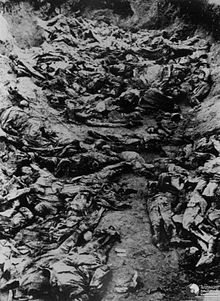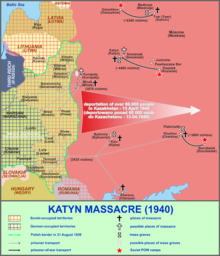
Back Slagting van Katyn Afrikaans مجزرة كاتين Arabic Katın qırğını Azerbaijani Катынь енәйәте Bashkir Катынскі расстрэл Byelorussian Катынскі расстрэл BE-X-OLD Катинско клане Bulgarian কাতিন গণহত্যা Bengali/Bangla Lazhadeg Katyn Breton Katinjski masakr BS
54°46′20″N 31°47′24″E / 54.77222°N 31.79000°E
| Katyn massacre | |
|---|---|
| Part of the aftermath of the Soviet invasion of Poland (during World War II) and Soviet repressions of Poles | |
 Mass grave of Polish officers in Katyn Forest, exhumed by Germany in 1943 | |
| Location | Katyn Forest, Kalinin and Kharkiv prisons in Soviet Union |
| Date | April–May 1940 |
| Target | Poles (military officers, intelligentsia, and prisoners of war) |
Attack type | War crime, decapitation, massacre |
| Deaths | 21,857[1] |
| Perpetrator | NKVD |

The Katyn massacre[a] was a series of mass executions of nearly 22,000 Polish military officers and intelligentsia prisoners of war carried out by the Soviet Union, specifically the NKVD ("People's Commissariat for Internal Affairs", the Soviet secret police) in April and May 1940. Though the killings also occurred in the Kalinin and Kharkiv prisons and elsewhere, the massacre is named after the Katyn forest, where some of the mass graves were first discovered by German Nazi forces.[2]
The order to execute captive members of the Polish officer corps was secretly issued by the Soviet Politburo led by Joseph Stalin.[3] Of the total killed, about 8,000 were officers imprisoned during the 1939 Soviet invasion of Poland, another 6,000 were police officers, and the remaining 8,000 were Polish intelligentsia the Soviets deemed to be "intelligence agents and gendarmes, spies and saboteurs, former landowners, factory owners and officials".[4] The Polish Army officer class was representative of the multi-ethnic Polish state; the murdered included ethnic Poles, Ukrainians, Belarusians, and 700–900 Polish Jews.[5]
The government of Nazi Germany announced the discovery of mass graves in the Katyn Forest in April 1943.[6] Stalin severed diplomatic relations with the London-based Polish government-in-exile when it asked for an investigation by the International Committee of the Red Cross.[7] After the Vistula–Oder offensive where the mass graves fell into Soviet control, the Soviet Union claimed the Nazis had killed the victims, and it continued to deny responsibility for the massacres until 1990, when it officially acknowledged and condemned the killings by the NKVD, as well as the subsequent cover-up by the Soviet government.
An investigation conducted by the office of the prosecutors general of the Soviet Union (1990–1991) and the Russian Federation (1991–2004) confirmed Soviet responsibility for the massacres, but refused to classify this action as a war crime or as an act of mass murder. The investigation was closed on the grounds that the perpetrators were dead, and since the Russian government would not classify the dead as victims of the Great Purge, formal posthumous rehabilitation was deemed inapplicable. In November 2010, hoping to improve relations with Poland, the Russian State Duma approved a declaration condemning Stalin and other Soviet officials for ordering the massacre. However, with the Russo-Ukrainian War, the relations became strained. In 2021, the Russian Ministry of Culture downgraded the memorial complex at Katyn on its Register of Sites of Cultural Heritage from a place of federal to one of only regional importance.[8]
- ^ Guryanov, Alexander, ed. (2015). Убиты в Катыни. Книга памяти польских военнопленных - узников Козельского лагеря НКВД, расстрелянных по решению Политбюро ЦК ВКП(б) от 5 марта 1940 года [Killed in Katyn] (PDF) (in Russian). Moscow: Memorial. p. 68. ISBN 978-5-78700-123-5.
- ^ "The Katyn Massacre – Mechanisms of Genocide". Warsaw Institute. 18 May 2020. Retrieved 11 April 2024.
- ^ Cite error: The named reference
Brown2009-140was invoked but never defined (see the help page). - ^ Cite error: The named reference
ipn_eng_news_high_katyn_decisionwas invoked but never defined (see the help page). - ^ Cite error: The named reference
controversywas invoked but never defined (see the help page). - ^ Cite error: The named reference
Engelwas invoked but never defined (see the help page). - ^ Cite error: The named reference
LeslieLeslie1983was invoked but never defined (see the help page). - ^ "The Katyn memorial complex", Russia's Necropolis of Terror and the Gulag Archived 22 November 2021 at the Wayback Machine.
Cite error: There are <ref group=lower-alpha> tags or {{efn}} templates on this page, but the references will not show without a {{reflist|group=lower-alpha}} template or {{notelist}} template (see the help page).
© MMXXIII Rich X Search. We shall prevail. All rights reserved. Rich X Search
